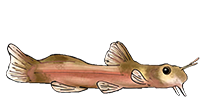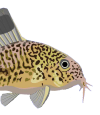/siluriformes/loricariidae/dekeyseria/picta/1.jpg) L052
L052/siluriformes/loricariidae/dekeyseria/picta/2.jpg) L168
L168/siluriformes/loricariidae/dekeyseria/picta/3.jpg)
/siluriformes/loricariidae/dekeyseria/picta/4.jpg) Coloration of intermediate-size fish ~90-130mm SL
Coloration of intermediate-size fish ~90-130mm SL/siluriformes/loricariidae/dekeyseria/picta/5.jpg) Coloration of larger fish >130mm SL
Coloration of larger fish >130mm SL/siluriformes/loricariidae/dekeyseria/picta/6.jpg) Male, elongated pelvic fin beyond pelvic fin spine
Male, elongated pelvic fin beyond pelvic fin spine/siluriformes/loricariidae/dekeyseria/picta/7.jpg) L052, 6 weeks old
L052, 6 weeks old/siluriformes/loricariidae/dekeyseria/picta/8.jpg) Ventral view
Ventral view Video - L052 pair spawned
Video - L052 pair spawned/siluriformes/loricariidae/dekeyseria/picta/10.jpg) L052
L052/siluriformes/loricariidae/dekeyseria/picta/11.jpg) L052
L052/siluriformes/loricariidae/dekeyseria/picta/12.jpg) L052
L052/siluriformes/loricariidae/dekeyseria/picta/13.jpg) L052
L052/siluriformes/loricariidae/dekeyseria/picta/14.jpg) L052
L052/siluriformes/loricariidae/dekeyseria/picta/15.jpg) L052
L052/siluriformes/loricariidae/dekeyseria/picta/16.jpg) Close-up of pectoral fin
Close-up of pectoral fin/siluriformes/loricariidae/dekeyseria/picta/17.jpg) L052
L052/siluriformes/loricariidae/dekeyseria/picta/18.jpg) Close-up of head
Close-up of head/siluriformes/loricariidae/dekeyseria/picta/19.jpg) L052
L052 Video: eggs of L052
Video: eggs of L052/siluriformes/loricariidae/dekeyseria/picta/21.jpg) L052
L052/siluriformes/loricariidae/dekeyseria/picta/22.jpg) L052. Young fry
L052. Young fry/siluriformes/loricariidae/dekeyseria/picta/23.jpg) L052. Fry after a few weeks
L052. Fry after a few weeks/siluriformes/loricariidae/dekeyseria/picta/24.jpg) L052. Fry from two different broods
L052. Fry from two different broods/siluriformes/loricariidae/dekeyseria/picta/25.jpg) L052. Young fry
L052. Young fry/siluriformes/loricariidae/dekeyseria/picta/26.jpg) L052
L052/siluriformes/loricariidae/dekeyseria/picta/27.jpg)
/siluriformes/loricariidae/dekeyseria/picta/28.jpg) L168
L168/siluriformes/loricariidae/dekeyseria/picta/29.jpg) L168
L168/siluriformes/loricariidae/dekeyseria/picta/30.jpg) L168, pair
L168, pair/siluriformes/loricariidae/dekeyseria/picta/31.jpg) L168, night time colouration fading into daytime colours
L168, night time colouration fading into daytime colours/siluriformes/loricariidae/dekeyseria/picta/32.jpg) L168, close-up of mouth
L168, close-up of mouth/siluriformes/loricariidae/dekeyseria/picta/33.jpg) L168
L168/siluriformes/loricariidae/dekeyseria/picta/34.jpg) L168
L168/siluriformes/loricariidae/dekeyseria/picta/35.jpg) L168, male with eggs in square pipe
L168, male with eggs in square pipe/siluriformes/loricariidae/dekeyseria/picta/36.jpg) L168, dorsal view
L168, dorsal view/siluriformes/loricariidae/dekeyseria/picta/37.jpg) L168
L168/siluriformes/loricariidae/dekeyseria/picta/38.jpg) L168
L168/siluriformes/loricariidae/dekeyseria/picta/39.jpg) L168
L168/siluriformes/loricariidae/dekeyseria/picta/40.jpg) L168
L168/siluriformes/loricariidae/dekeyseria/picta/41.jpg) Coloration of smaller (young) fish below ~90mm SL
Coloration of smaller (young) fish below ~90mm SL/siluriformes/loricariidae/dekeyseria/picta/42.jpg) L168
L168/siluriformes/loricariidae/dekeyseria/picta/43.jpg) L168
L168/siluriformes/loricariidae/dekeyseria/picta/44.jpg) Dorsal view
Dorsal view/siluriformes/loricariidae/dekeyseria/picta/45.jpg) L168, newly hatched fry
L168, newly hatched fry/siluriformes/loricariidae/dekeyseria/picta/46.jpg) L168
L168/siluriformes/loricariidae/dekeyseria/picta/47.jpg) L168, male guarding eggs
L168, male guarding eggs/siluriformes/loricariidae/dekeyseria/picta/48.jpg) L168
L168/siluriformes/loricariidae/dekeyseria/picta/49.jpg) L168
L168
| Scientific Name | Dekeyseria picta (Kner, 1854) |
| Common Names | L052, Butterfly Pleco L168, Orinoco Butterfly Pleco, Atabapo Butterfly Pleco, Brasiliansk Sommerfuglesugemalle (Denmark), Brazil Butterfly-Pleco (Germany), Flounder Pleco, Flounder Pleco, Gebänderter Zwergschilderwels (Germany) |
| Type Locality | Manaus, Brazil. |
| Synonym(s) | Ancistrus brachyura, Ancistrus brachyurus, Ancistrus pictus, Ancistrus pulcher, Dekeyseria brachyura, Dekeyseria brachyurus, Dekeyseria pulcher, Peckoltia brachyura, Peckoltia picta, Peckoltia pulcher, Zonancistrus brachyurus, Zonancistrus pictus, Zonancistrus pulcher |
| Pronunciation | dee key SEAR ee ah - pik tah. |
| Articles | |
| Size | 140mm or 5.5" SL. Find near, nearer or same sized spp. |
| Identification | Similar to Lasiancistrus but broader when viewed from above especially in larger adults. Striped species of Dekeyseria were placed in Zonancistrus but because this was only based on colouration, they are more commonly placed with the non-striped species in Dekeyseria. This catfish is a master of disguise. It can change colouration, chameleon-style, quickly. If kept on a black or very dark substrate is will go almost black. Kept on a lighter substrate it will show a pretty striped pattern during the day. Another reason for misidentification of this fish is that its night-time colouration is totally different from that it has during the day, some authors note this is adult versus juvenile colouration. In more southerly occurring populations, the stripes are more clearly separated and the base colour of D. brachyura is more orange when you compare them directly. This species can be found in many hobbyist books under its old name of Peckoltia pulcher. More recently it was moved by Isbrucker et al into their new flounder pleco genus Zonancistrus. However, prevailing scientific usage appears to be with the use of Dekeyseria. L052, is a pattern variant from the Atabapo drainage has stripes that are less clearly separated and form a network pattern in adults. The following data was recorded from an adult male specimen of L052 Male SL 97.0 mm TL 121.0 mm Dorsal: I,7 Pectorals: I,6 Pelvic: I,5 Anal: 4 Interopercular spines: coloured yellowish and straight. The very ends of these spines are curved like a hook and are a red/pink in colour. |
| Sexing | Mature males have substantial odontodes both on the thick pectoral ray and the posterior part of the body. The male also have a broader head than the female. |
| General Remarks | L168 was collected in the Rio Demini (Negro Basin). |
| Distribution | South America: Lower Negro River basin in BRazil. Amazon, Middle Amazon (Solimoes), Negro (click on these areas to find other species found there) Orinoco, Middle Orinoco, Atabapo (click on these areas to find other species found there) Amazon, Middle Amazon (Solimoes), Negro, Lower Negro (click on these areas to find other species found there) Orinoco, Upper Orinoco (click on these areas to find other species found there) Amazon, Middle Amazon (Solimoes), Negro, Upper Negro, Casiquiare (click on these areas to find other species found there) Amazon, Middle Amazon (Solimoes), Negro, Upper Negro (click on these areas to find other species found there) Amazon, Middle Amazon (Solimoes), Negro, Demini (click on these areas to find other species found there) Login to view the map. |
| IUCN Red List Category | Least Concern , range map and more is available on the IUCN species page. Last assessed 2020. |
| pH | 5.6 - 6.8 |
| Temperature | 24.0-27.0°C or 75.2-80.6°F (Show species within this range) |
| Other Parameters | Water should be soft, well oxygenated, warm and a little bit acidic to attempt breeding. |
| Feeding | Tablet food, vegetarian foods and insect larvae. Doesn't eat wood but will eat readily from its surfaces. User data. |
| Furniture | Open spaces, large flat surfaces and shade provided by leafy cover or the lower light conditions of blackwater. Plants are not necessary but are generally left unmolested especially if the fish is being fed properly. |
| Compatibility | Peaceful and doesn't appear overly territorial with its own kind. |
| Breeding | Broods varying between 50 to 120 eggs. The eggs take a long time to develop and hatch (9-10 days). The fry are well developed and are almost without a yolk sac. The fry are very fast growing. |
| Breeding Reports | There are 9 breeding reports, read them all here. |
| Reference | Denkschriften der Kaiserlichen Akademie der Wissenschaften in Wien, Mathematisch-Naturwissenschaftliche Classe. v. 7, pp 277 [27], Pl. 4 (fig. 2). |
| Registered Keepers | There are 365 registered keepers, view all "my cats" data. |
| Wishlists | Love this species? Click the heart to add it to your wish list. There are 18 wishes to keep this species, see who wants what. |
| Spotters | Spotted this species somewhere? Click the binoculars! There are 116 records of this fish being seen, view them all. |
| Forum BBCode | |
| Search for D. picta | |
| Look up D. picta on AquaticRepublic.com | |
 | Look up D. picta on Fishbase |
 | Look up D. picta on Encyclopedia of Life |
 | Look up D. picta on Global Biodiversity Information Facility |
| LFS label creator ARN ref:1.4.58.3924 | |
| Last Update | 2025 Jan 01 12:09 (species record created: 2011 Sep 23 05:21) |




